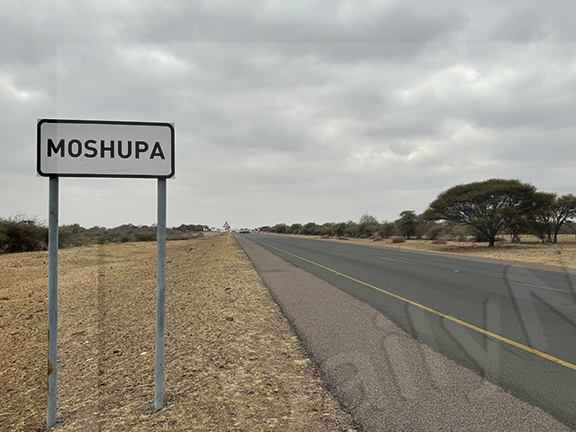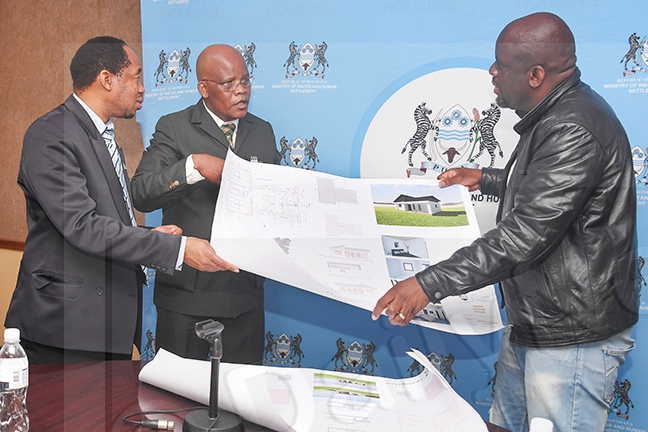Infrastructure development delivered
31 Mar 2023
On April 1, 2018 in his inauguration speech, President Dr Mokgweetsi Masisi said government would continue to invest in infrastructural development
projects across various sectors.
These include Information and Communication Technology (ICT), water energy, transport and road networks to create an environment for commerce and industry as well as stimulate the economy.
He said in implementing these projects, government’s guiding documents would be the National Vision 2036, which sought to achieve Prosperity for all.
Fast forward to 2023, the President had delivered on his promises. For instance, the country’s capital was face lifted as a result of numeral infrastructure that include Gaborone Interchanges and Gaborone- Boatle dual carriage way.
The construction of three intersections at KT Motsete-Wellie Seboni (BTV Circle), Kudumatse Drive (Rainbow Circle) and Lobatse Road (Game City Circle) has improved the road infrastructure and outlook of Gaborone. Other parts of the intersections have been opened for traffic with the rest expected to be open during the course of the year.
These intersections are part of the greater Gaborone multi- modal transport, which include installation of new traffic signalling system and a centralised traffic control.
Upgrading of Gaborone- Boatle road is part of infrastructure development to enhance transport system efficiency. Such upgrading eased traffic congestion and reduced delays and travel times in Greater Gaborone.
The road was built through Economic Stimulus Programme (ESP) and promoted Citizen Diversification Drive hiring 12 Botswana companies as sub- contractors at the value of P255 million.
Furthermore, the President also assured to improve the country’s road infrastructure. As promised, tenders for shoulder reinstatement and Asphalt overlay of Gumare-Sepopa road (70km) has been awarded as well as the Sepopa-Mohembo 70km road sections. The Minister of Transport and Public Works Mr Eric Molale conducted the ground-breaking on January 18, 2023.
Tshesebe- Masunga road project is ongoing standing at a progression of 62 percent against the planned 75 percent. The delays have been attributed to deferrals in manufacturing and transportation of bridge bearings, rainfall disruptions on processing of pavement layers and culverts installations.
On other development government has managed to construct a 155 metre long Platjaan Bridge, which was completed in 2020 at a cost of P105 million.
The bridge was as a result of bilateral agreement between Botswana and South Africa where Botswana committed to the construction of a bridge across Limpopo River while South Africa agreed to construct one across Notwane River.
This project underscores Botswana’s commitment with neighboring countries in regional integration and development of strategic infrastructure for improved trade, job creation and economic diversification.
The construction of this bridge has upgraded the Platjaan border post to a fully commercial border post and further boosted the Selebi Phikwe Economic Diversification Unit (SPEDU) region economically.
As far as rail transport is concerned, Botswana and South Africa on March 3 signed a joint Development Agreement for the construction of the Mmamabula-Lephalale railway project.
The 130 kilometres railway will run from Mmamabula coalfields to Lephalale in South Africa with the project funded by both governments. It is expected to open up a higher capacity heavy-duty coal line and other commodities export to South Africa and other Sea Ports.
Also, the government has undertaken to improve and increase revenue offices across the country with the Shakawe Revenue office project completed in December 2020 at a cost of P44 million while in Hukuntsi, a revenue office comprising staff houses was opened in November 2022 valued at P43 million.
The offices have created a conducive working environment and comfortable residences, which would allow officers to perform their roles satisfactorily. These facilities show government’s commitment to improving service delivery in economically challenged constituencies.
The new buildings also enable customers and staff to interact in more spacious facilities.
Another notable project is the electrification of schools that are outside the power grid (Solar Power Project), which has been completed.
The last phase of the project was planned under NDP 11 with 12 Primary schools electrified under the final batch being Sankoyo, Khwee, Lepashe, Mababe, Losilakgokong, Khekhenye, Sorilatholo, Mokgenene and Makakung. Works are ongoing for Khwai, Tshwaane, and Poloka schools.
Ministry of Transport and Public Works was granted P3.1 billion to cater for ongoing major projects; output and performance road based contract of Mmankgodi-Jwaneng and Rakhuna-Mabule; Tshesebe-Masunga and completion of upgrading of three Intersections of KT Motsete Drive, Rainbow and Game city circles as well as final payments for Gaborone- Boatle dual road.
The proposed budget will also cater for the construction of Mmandunyane-Shashemooke- Borolong-Chadibe-Mathangwane; Mogoditshane-Gabane-Mmankgodi; Boatle-Lobatse; Palapye-Martins Drift; Nata-Kasane; Makalamabedi-Motopi; Nata-Maun reconstruction; Francistown- Nata reconstruction and Mmathete-Bray-Werda.
…And the water projects
Monumental Kazungula bridge
The tolling system at Kazungula following completion and the eventual commissioning of the Kazungula Bridge in May 2021 is proving to be a cash cow for both Botswana and Zambia.
Last year on International Customs Day Commemoration, Botswana Unified Revenue Service (BURS) revealed that since opening, the Kazungula Bridge had raked in over P18 million in tollgate revenue, with P2 million collected on a monthly basis.
The magnificent Kazungula Bridge is a joint venture between Botswana and Zambia, stretching 923 metres across the enormous Zambezi River. It lies at the quadro point where four countries uniquely meet along the North-South Corridor (NSC), a critical trade route for SADC countries.
It comprises a road and rail bridge over the Zambezi River directly linking Botswana and Zambia with one-stop border post facilities on both sides, which enhances operational efficiency at entry point.
Speaking during the opening of the bridge in 2021, President Dr Mokgweetsi Masisi said the bridge was testimony to the ever-growing scope and scale of cooperation, which Botswana and Zambia had enjoyed since the colonial era.
He said the Kazungula Bridge opened avenues for improved trade, job creation and economic diversification in the two countries and would significantly accelerate SADC’s regional integration agenda.
“Goods from Lesotho, eSwatini, South Africa, Namibia, Zambia, Democratic Republic of Congo, Tanzania, Angola and Kenya and other countries in the North will use the Bridge in true spirit of the African Continental Free Trade Agreement,” observed the President.
Mohembo Bridge
The commissioning of the monumental Mohembo Bridge has accorded people of the Okavango a new meaning to life having been for time immemorial geographically divided by the mighty Okavango River.
In the past, these residents used an unreliable pontoon to visit and attend family events such as funerals and weddings in Okavango East popularly known as overseas, a mission that was at times unattainable when the ferry was out of service.
However the official opening of this bridge by President Dr Mokgweetsi Masisi on January 2 was a remarkable and life transforming development that has eased movement of people and goods in the Okavango area.
Kgosi Mutemo Mbambo of Shakawe said the newly constructed bridge had improved socio-economic status of the people of Okavango in that people were now able to conduct businesses freely without movements restricted by operations time of the ferry.
He highlighted that previously, people were reluctant to buy goods in Shakawe or any Western side of the Bridge to avoid incurring damage costs caused by mode of transport and waiting long hours for transportation by the ferry.
“Kana maloba jale go ne go le botlhoko tota fa le tlhokafaletswe ke losika ka kwano kana ka kwa. Batho ba tla nne ba sale batsile malatsi pele ga phitlho go itsa gore ba seka ba siiwa ke nako ya pantone. Mme mo malatsing a re bona masika a rona re gololesegile, mme ebile phetogo e e re itumedisa letsatsi le letsatsi,” said Kgosi Mbambo in his explanation that the ferry made it difficult for the people of Okavango West and East to attend each other’s events.
He said this treasure of a Bridge had even motivated the youth to venture into transportation businesses of people and goods between Okavango East/West villages.
The construction of the bridge project was fully funded by the Government of Botswana under Domestic Development Fund (DDF) at a cost of P1 billion.
This project entailed construction of about 1.2 kilometres of bridge and about three kilometres of approach roads to the bridge as well as associated drainage, electrical installation and reticulation to the bridge.
In his remarks at the official opening of the bridge, President Masisi said the bridge had significant positive impact on socio- economic outlook of the villages of the Okavango such as Mohembo, Kauxwi, Xakao, Sekondomboro, Ngarange, Mogotlho, Seronga, Gunotsoga, Eretsha, Beetsha and Gudigwa.
‘’The time interval for transportation of goods across the Okavango River has significantly improved and this will reduce the costs of doing business, or of implementing government projects, which were brought about by the delays in the ferrying of supplies of materials to construction sites on the Eastern side of the river.” President Masisi said.
He pointed out that the newly constructed bridge cancelled the restriction of movement for residents of Okavango that was in the past imposed by the schedule of time the pontoon operated with. Ends
Source : BOPA
Author : Portia Ikgopoleng
Location : Gaborone
Event : Interview
Date : 31 Mar 2023





